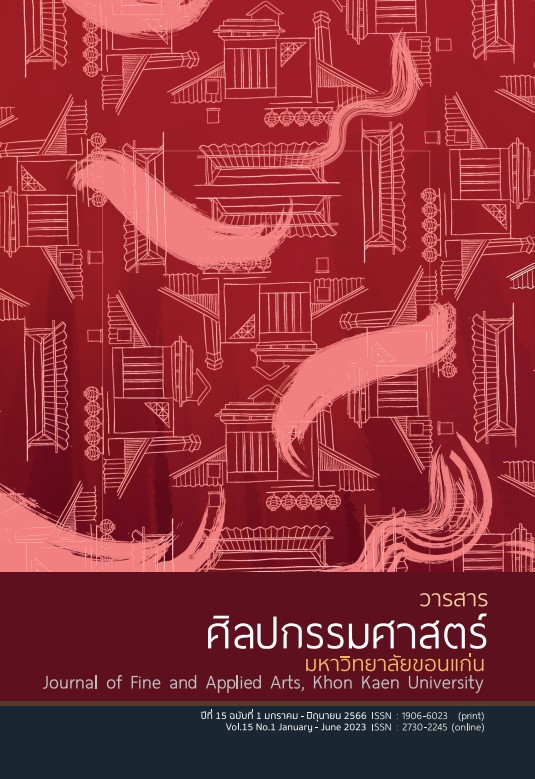ผลงานสร้างสรรค์ : นาฏยลีลาภูมิปัญญาดอกไม้ใบยางบ้านวังฆ้อง
Main Article Content
บทคัดย่อ
งานวิจัยนี้ใช้รูปแบบการวิจัยและพัฒนามีวัตถุประสงค์เพื่อ 1) ศึกษาองค์ความรู้ภูมิปัญญาการทำดอกไม้จากเส้นใยใบยางของกลุ่มวิสาหกิจชุมชนบ้านวังฆ้อง 2) สร้างสรรค์ชุดนาฏยลีลาภูมิปัญญาใบยาง กลุ่มตัวอย่างให้ข้อมูลด้านองค์ความรู้ได้แก่นักวิชาการ 8 คน ผู้เชี่ยวชาญด้านการแสดง 2 คน ปราชญ์ชาวบ้าน 6 คน กลุ่มตัวอย่างการสร้างสรรค์ผลงานได้แก่ นักศึกษาสาขานาฏศิลป์ มหาวิทยาลัยราชภัฏนครศรีธรรมราช 11 คน และผู้ชมที่ประเมินความพึงพอใจ 50 คน ผู้วิจัยเก็บข้อมูลโดยการสัมภาษณ์เชิงลึกแบบมีโครงสร้าง การสังเกตแบบมีส่วนร่วม และแบบสอบถาม จากนั้นทำการวิเคราะห์เนื้อหาและสถิติพรรณนา ผลการวิจัยพบว่าภูมิปัญญาการทำหัตถกรรมใบยางนำมาออกแบบสร้างสรรค์นาฏยลีลาได้ 4 ขั้นตอน เริ่มจากเก็บใบยาง หมักใบยาง ฟอกใบยาง และเข้าช่อใบยาง ทิศทางการเคลื่อนที่แปรแถว ใช้จำนวน 12 แบบ มีท่ารำจำนวน 20 ท่ารำ และแบ่งท่ารำตามทำนองเพลงเป็น 4 ช่วง เครื่องแต่งกายออกแบบตามแบบปกติที่ชาวบ้านสวมใส่ได้ในชีวิตประจำวันโดยเพิ่มเครื่องประดับร่างกาย และเครื่องประดับศีรษะ อุปกรณ์ประกอบการแสดงประดิษฐ์ขึ้น 3 ชนิด ได้แก่ โคมไฟใบยาง พานพุ่มใบยาง และพวงหรีดใบยางที่สะท้อนถึงความเป็นปักษ์ใต้ ดนตรีประกอบเป็นการผสมผสานของเพลงการแสดงหนังตะลุงและการเล่นลิเกป่าที่สะท้อนเอกลักษณ์ดนตรีปักษ์ใต้ ผลการประเมินความพึงพอใจพบว่าผู้ชมมีความพึงพอใจในระดับมากที่สุดจำนวน 7 ข้อ ได้แก่ พึงพอใจต่ออุปกรณ์ประกอบการแสดง (ค่าเฉลี่ย 4.69) เป็นชุดการแสดงทางวัฒนธรรมวิถีชีวิตของชุมชน (ค่าเฉลี่ย 4.64) การแสดงสะท้อนการทำอาชีพดอกไม้ใบยาง (ค่าเฉลี่ย 4.63) อุปกรณ์ประกอบสามารถนำไปพัฒนาผลิตภัณฑ์ได้ (ค่าเฉลี่ย 4.61) เพลงประกอบฟังรู้เป็นของภาคใต้ (ค่าเฉลี่ย 4.60) นำไปแสดงได้ในทุกโอกาส (ค่าเฉลี่ย 4.60) และส่งเสริมคุณค่าทางเศรษฐกิจในชุมชน (ค่าเฉลี่ย 4.56)
Article Details

อนุญาตภายใต้เงื่อนไข Creative Commons Attribution-NonCommercial-NoDerivatives 4.0 International License.
เนื้อหาและข้อมูลในบทความที่ลงตีพิมพ์ในวารสารคณะศิลปกรรมศาสตร์ มหาวิทยาลัยขอนแก่น ถือเป็นความคิดเห็นและความรับผิดชอบของผู้เขียนบทความโดยตรง ซึ่งกองบรรณาธิการไม่จำเป็นต้องเห็นด้วย หรือร่วมรับผิดชอบใด ๆ
บทความ ข้อมูล เนื้อหา รูปภาพ ฯลฯ ที่ได้รับการตีพิมพ์ในวารสารคณะศิลปกรรมศาสตร์ มหาวิทยาลัยขอนแก่น ถือเป็นลิขสิทธิ์ของวารสารคณะศิลปกรรมศาสตร์ มหาวิทยาลัยขอนแก่น หากบุคคลหรือหน่วยงานใดต้องการนำทั้งหมดหรือส่วนหนึ่งส่วนใดไปเผยแพร่ต่อหรือเพื่อกระทำการใด ๆ จะต้องได้รับอนุญาตเป็นลายลักอักษรจากวารสารคณะศิลปกรรมศาสตร์ มหาวิทยาลัยขอนแก่น ก่อนเท่านั้น
เอกสารอ้างอิง
กัลยาณี เจ๊กท่านา. (2563). การสร้างสรรค์นาฏศิลป์พื้นบ้านประยุกต์ชุดระบำกล้วยตาก ผ่านกระบวนการ วิจัยเชิงสร้างสรรค์. วิทยานิพนธ์ปริญญาการศึกษามหาบัณฑิต สาขาวิจัยและประเมินทางการศึกษา บัณฑิตวิทยาลัย มหาวิทยาลัยนเรศวร.
จรรย์สมร ผลบุญ. (2560). การสืบสานการแสดงรองเง็งตันหยงโดยใช้สื่อท่ารำต้นแบบ. วารสารมหาวิทยาลัยราชภัฏยะลา, 12(1), 29–43.
พิริยะ ผลพิรุฬห์. (2556). เศรษฐกิจสร้างสรรค์กับการพัฒนาประเทศไทย. วารสารเศรษฐศาสตร์ปริทรรศน์ สถาบันพัฒนศาสตร์, 7(1), 1–69.
สุรพล วิรุฬห์รักษ์. (2547). หลักการแสดงนาฏยศิลป์ปริทรรศน์. กรุงเทพฯ : สำนักพิมพ์แห่งจุฬาลงกรณ์มหาวิทยาลัย.
อรศิริ รักแตงงาม. (2552). ยางพารา พืชเศรษฐกิจไทย ใส่ใจโลกร้อน. ค้นเมื่อ 3 กรกฎาคม 2563, จาก http://orasirii.blogspot.com/2009/10/blog-post_6038.html
อีโต้น้อย. (2560). การพัฒนาสังคมไทยที่ต้องสร้างความภูมิใจกับภูมิปัญญาท้องถิ่น. ค้นเมื่อ 3 กรกฎาคม 2563, จาก https://etonoy.srru.ac.th/


